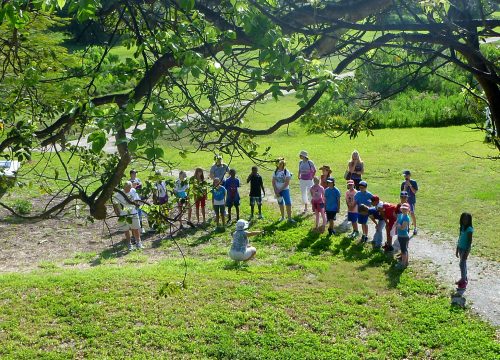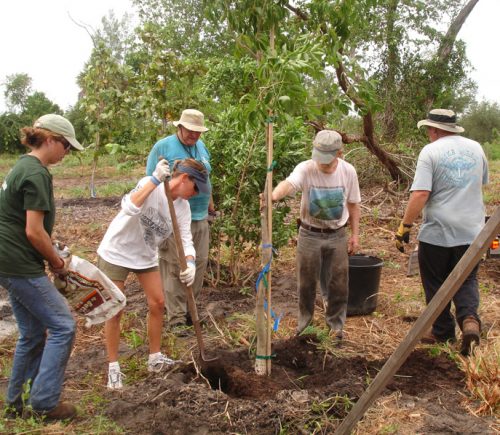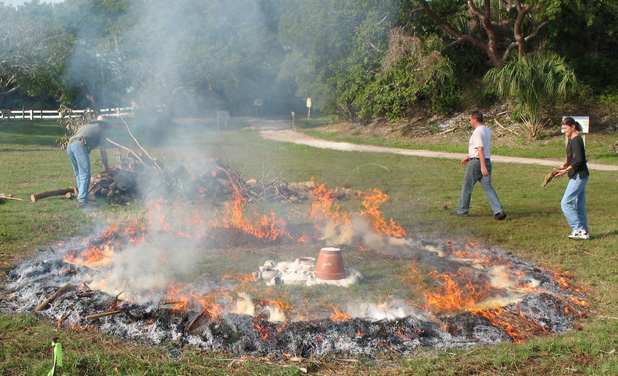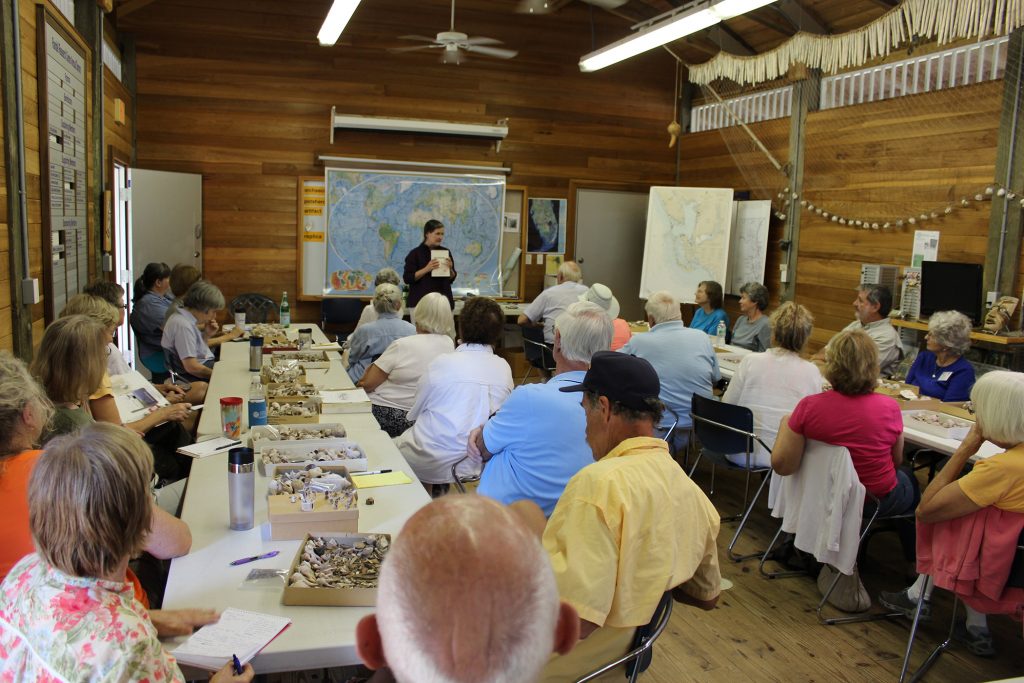As part of our celebration of the RRC’s 25th anniversary, we invited Bill Marquardt, RRC’s co-founder and first director, to summarize some of the key events in its history.

Close your eyes for a minute and listen. Unless you are hearing-impaired, you are likely to notice something – traffic, a distant air conditioner, the cooling fan of your computer, maybe your refrigerator. If you are outdoors, perhaps you’ll hear a bird’s song or the rustle of wind in the trees. As Karen Walker and I sat on the front porch of the Ruby Gill House eating our PB&J sandwiches on August 14, 2004, it was truly silent – no traffic, no machines, no birds, no wind, not even a fly or a mosquito. A compact, fast-moving, and powerful hurricane named Charley had roared across the northern end of Pine Island the day before, hurrying on to Orlando and points beyond. Karen and I had packed the car with ice, water, and food that required no refrigeration (hence PB&J for dinner) and driven to Pineland from Gainesville to assess the damage and begin clean-up.
Vegetation was down everywhere, especially non-native species. Signs were missing, electric power and phone service were non-existent. The teaching pavilion at the site, built to resist serious storms, was unharmed, but the roofs of the Gill House and post office had leaked, so first we swept out the water and secured the roofs with tarps. Then we began to clean things, using the abundant rainwater from the cistern. Within a few days, friends and colleagues showed up from Gainesville with work clothes, big coolers of food, and drinking water, and the first phase of cleanup was accomplished amidst the searing summer heat (RRC News, Vol. 3, No. 4). After securing their own homes, John Worth and his staff continued on.
Hurricane Charley delayed the opening of the long planned Calusa Heritage Trail until December. The Trail had been funded in part by a grant from the Florida Division of Historical Resources and sponsored by a leadership gift from Dwight and Susan Sipprelle.
Citrus canker invaded South Florida in the aftermath of Charley. Although there was no canker on our trees, authorities insisted on destroying the RRC’s trees and those of our neighbors, erasing the last vestiges of historic groves that had once dominated Pineland.

In December, 2005, the Gill House and Pineland Post Office were added to Lee County’s list of Designated Historical Resources. A grant from the Florida Division of Forestry helped with habitat restoration in 2006 and 2007, a process made difficult by a drought. With the help of volunteers and the guidance of professionals Brady Vogt and John Cauthen, we planted 800 native trees and shrubs.
A matching grant from the State allowed us to complete architect Jeff Mudgett’s design for the classroom and giftshop portion of the visitor center in 2006. Furniture was installed, and the first public lecture was offered on January 13, 2007. Later that year, the National Endowment for the Humanities funded the curation and storage of materials excavated at Pineland 1988-1995 and all associated records. An unexpected event in 2007 was the destruction of a portion Brown’s Complex Mound 4 for the enlargement of a septic drainfield on private property (RRC News, Vol. 7, No. 3). This had been required by the County Health Department, and Pineland was not on the County’s list of historical resources. This was remedied in January 2018 so that now archaeologists can be involved when similar situations arise.
Meanwhile, grants were received from the Lee County Historic Preservation Board, first to stabilize the Gill House and post office, then to create a master historic-preservation plan for rehabilitating the Gill House. Architect Linda Stevenson created the plan and Bob Rude provided structural engineering consultation. Funds were received from the Lee County Tourist Development Council, the Arts and Attractions Fund of the Southwest Florida Community Foundation, and many private citizens, including leadership gifts from Paul and Warren Miller and Dwight and Susan Sipprelle. Rehabilitation was completed by general contractor Dale Schneider in 2010 (RRC News, vol. 9, no. 2). We were able not just to bring the house back to where it was before, but to improve it with a better heating and cooling system, a hard-wired Internet, and a stronger structure, including the roof. In 2009, with assistance from FEMA, we restored the old dock across the street from the Randell Mound, creating an observation pier for the public. FEMA also paid for a new maintenance structure to replace the old “tractor shed” that had been blown down by Charley.
Research continued: climate-change studies by Karen Walker, Donna Surge, and Ting Wang; Michael Wylde’s excavations on Brown’s Complex Mound 5; and Melissa Ayvaz’s on Citrus Ridge. Cindy Bear joined our staff as coordinator in 2011. The sixth annual Calusa Heritage Day in March attracted more than 800 to the site, as did the seventh in 2012. In fall 2012, RRC archaeologists and volunteers explored deposits on the southern end of Useppa Island that dated to some 3,000 years ago. In 2013, The Archaeology of Pineland book was published. In fall 2013, Cindy led a project to enhance interpretive materials in the classroom and to improve the trail leading to the Smith Mound, both funded by an Arts and Attractions grant from the Southwest Florida Community Foundation. She also improved docent and volunteer training, promoted visits by school children, began the Harbor History tours in cooperation with Captiva Cruises and the Tarpon Lodge and narrated by Denége Patterson, and taught Florida Master Naturalist classes at Pineland.
The ninth Calusa Heritage Day was held in March 2014, and in the fall our first RRC popular-series book became available: Marty Kendall’s The Plant World of the Calusa. The year 2015 saw the funding of a new grant from the National Science Foundation for research on fuelwoods by Lee Newsom, Karen Walker, and Jennifer Haney, as well as the purchase of five acres, adding the Smith and Low mounds to the managed RRC property. Funding was provided ¾ by Tim and Judith Sear and ¼ by the Calusa Land Trust. In the summer of the same year, an emergency salvage project in the front yard of the Wilson Sisters house at Pineland revealed extraordinarily well-preserved wood and cordage dating to around 1,000 years ago.
In 2016, Cindy coordinated removal of exotic invasive vegetation from the new 5-acre parcel, funded by the Felburn Foundation, and interpretive signs were designed by Merald Clark thanks to support from the Florida Humanities Council. The new extension of the Calusa Heritage Trail opened in spring, 2017 and that same year saw the second in our popular series, Denége’s A Tour of the Islands of Pine Island Sound; the tenth Calusa Heritage Day; and a follow-up investigation of the shoreline midden first discovered in 2015.
Guided tours for the public as well as focused school tours continued, conducted by our docents. A new endowment funded by the Sear Family Foundation allowed us to bring children from elementary schools to the site who had not previously had that opportunity due to financial constraints.
By 2019, the RRC was hosting more than 10,000 visitors per year from many parts of the U.S. and several foreign countries and was being assisted by more than 75 volunteers. By 2020, however, the COVID-19 virus was causing uncertainty and caution. Cindy and her staff responded with changes to the visitor center, hands-free drinking fountain and restroom faucets, a new payment system for the gift shop, and masking requirements in group settings.
With the retirements of Bill Marquardt (2018), Cindy Bear (2021), and Karen Walker (2021), new RRC leaders assumed their roles. Annisa Karim became the new Operations Manager, Charlie Cobb the Director, Michelle LeFebvre the Assistant Director, and Jennifer Green the Collections Manager. September 28, 2022, brought a new challenge to southwest Florida in the form of Ian – like Charley, a powerful Category 4 hurricane, but larger, slower-moving, and more flood-producing. Large parts of Fort Myers Beach, Matlacha, and Pine Island were devastated. Bridges and causeways were washed away. A storm surge damaged the historic Pineland Post Office and Gill House. Exacerbating the problem was the initial difficulty of access to the island due to the destruction at Matlacha.
In my final article as Director of the RRC (RRC News, vol. 17, no. 2), I reflected on resiliency and how both the Calusa people and the RRC had managed time and time again to respond to new challenges. Ian is not the last hurricane that will impact Pine Island. Global warming is increasing the likelihood and frequency of serious storm damages. As new leaders of the RRC work through the process of recovery and rehabilitation, I hope all who read this will continue to support the RRC with their money and time. There is nothing else like it, and it is worth it.
More
- A Brief History of the Randell Research Center, Part 1: 1988-1996
- A Brief History of the Randell Research Center, Part 2: 1997-2004
This article was taken from the Friends of the Randell Research Center Newsletter Vol 22, No. 1 & 2. November 2023.

